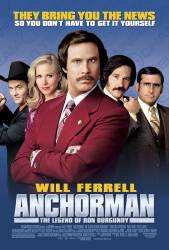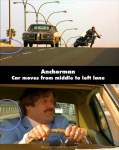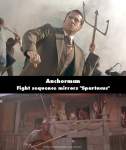Factual error: Although the film is set in the 1970s, the San Diego Convention Center can be seen in several skyline shots of the city of San Diego throughout the film. It was built during the mid 1980s.
Factual error: The movie is set in the 1970's, yet when Brian Fantana is reporting from the zoo, a man wearing a U.S. army jacket walks behind him. The jacket is of the woodland camouflage design which was not made until the 1980's.
Factual error: Although the film is set in the 1970's, Petco Park (The San Diego Padre's ballpark) can be seen in a skyline shot of the city of San Diego. It wasn't built until around 2001-2002.
Factual error: Throughout the movie, there are shots of downtown San Diego, which is supposed to be set in the 1970s. Yet, there are shots of One America Plaza, the tallest building in San Diego, which was built in 1991.
Factual error: Although the film is set in the 1970s, the Emerald Shapery Tower can be seen in several skyline shots of the city of San Diego throughout the film. It was built during the mid 1980's.
Factual error: The movie takes place in the 1970s, yet the Channel 4 news van is an early 1980s model Dodge Ram Van.
Factual error: In the scene where Ed Harkin calls the bar to ask if Ron Burgundy is there, you can see a calendar to the far right of the bartender. It is the calendar for July, and the 1st of July is a Tuesday. 1975 is the only year in the 1970's that this could be possible. "Afternoon Delight" (the song the news team sings when Veronica Corningstone is introduced) wasn't out until one year later, July of 1976.
Factual error: When Ron and the biker are talking on the bridge, a red cube van passes by in the background. Look closely: It's a 1990s model Ford Econoline, yet the movie takes place in the 1970s.
Factual error: The cologne scene shows a 90's era Corvette cologne. (00:14:15)
Factual error: Although the film is set in the 1970's, when Brian Fantana is on the phone talking with a distraught Ron Burgundy, a Rubik's Cube is seen on the desk. Rubik's Cube was not sold until the early 1980's.
Suggested correction: First of, what it is isn't Rubik's original "Magic Cube" (later called Rubik's Cube). It's a 2x2x2 puzzle that looks like what Larry Nichols invented in 1968 and patent in 1972. The Rubik's Cube is 3x3x3.







